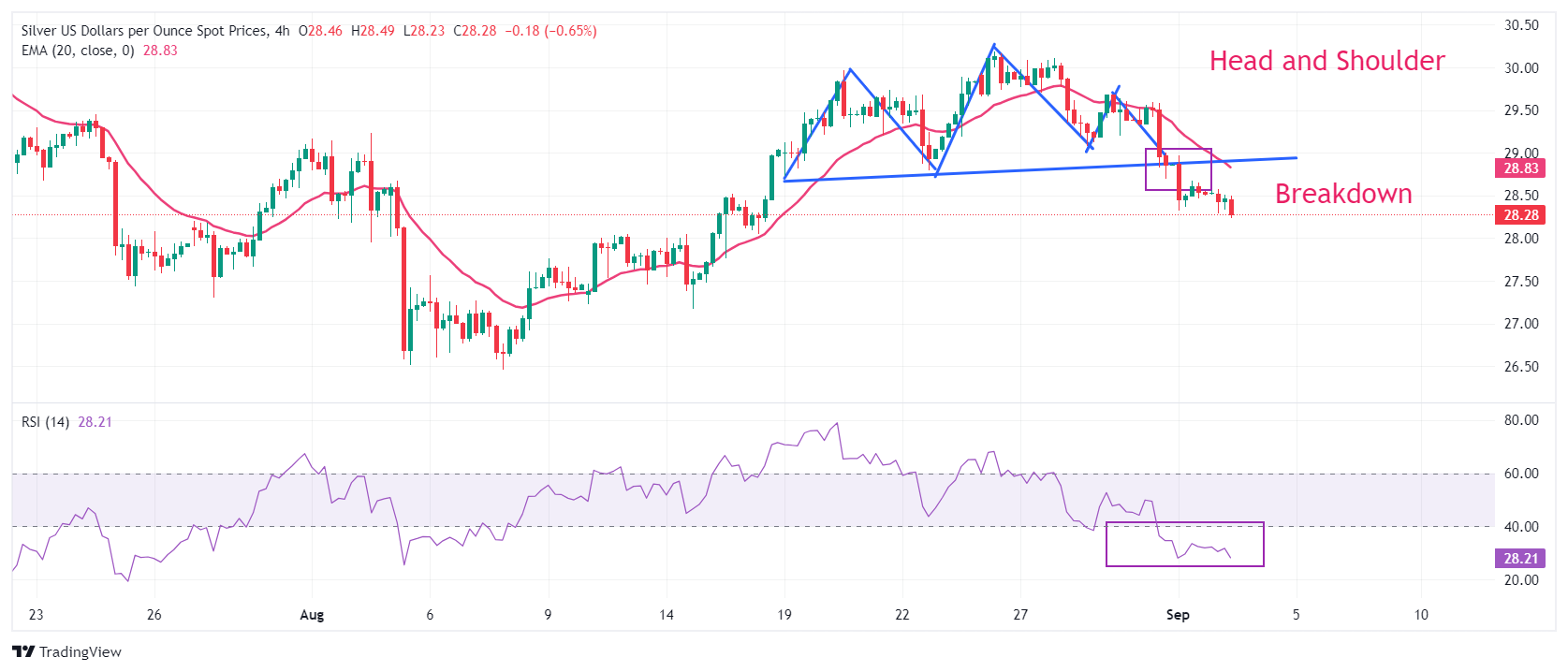- Analiza
- Novosti i instrumenti
- Vesti sa tržišta
- Silver Price Forecast: XAG/USD plunges to near $28 ahead of busy US data week
Silver Price Forecast: XAG/USD plunges to near $28 ahead of busy US data week
- Silver price falls sharply to near $28.20 as the US Dollar rises further.
- Traders remain split over the Fed’s potential rate cut size in the September meeting.
- Investors await the US Manufacturing PMI data for August.
Silver price (XAG/USD) extends its losing spree for the third trading session on Tuesday. The white metal declines to near $28.20 as the US Dollar (USD) rises further amid uncertainty ahead of a slew of United States (US) economic data this week.
The US Dollar Index (DXY), which tracks the Greenback’s value against six major currencies, rises toward fresh two-week high of 102.00.
Investors keenly await the US Nonfarm Payrolls (NFP) data for August, releasing on Friday, as it will influence market speculation for the likely size of interest rate cut by the Federal Reserve (Fed) in the September meeting.
The Fed is widely anticipated to start reducing interest rates this week but traders are divided on whether the central bank will kick-off the policy-easing cycle gradually or aggressively. Apart from the US NFP report, investors will also focus on the JOLTS Job Openings data for July and the ADP Employment Change data for August, which will be published on Wednesday and Thursday, respectively, that will provide fresh cues on current labor market status.
In today’s North American session, investors will focus on the US ISM Manufacturing PMI data for August, which will be published at 14:00 GMT. The US Manufacturing PMI is estimated to have improved to 47.5 from July’s reading of 46.8 but a figure below 50.0 is itself considered as contraction.
Silver technical analysis
Silver price weakens after a breakdown of the Head and Shoulder chart pattern on a four-hour timeframe, whose neckline is plotted near $28.80. Declining 20-period Exponential Moving Average (EMA) near $28.80 suggests that the near-term trend is bearish.
The 14-period Relative Strength Index (RSI) shifts into the bearish range of 20.00-40.00, suggesting a strong bearish momentum.
Silver four-hour chart
Silver FAQs
Silver is a precious metal highly traded among investors. It has been historically used as a store of value and a medium of exchange. Although less popular than Gold, traders may turn to Silver to diversify their investment portfolio, for its intrinsic value or as a potential hedge during high-inflation periods. Investors can buy physical Silver, in coins or in bars, or trade it through vehicles such as Exchange Traded Funds, which track its price on international markets.
Silver prices can move due to a wide range of factors. Geopolitical instability or fears of a deep recession can make Silver price escalate due to its safe-haven status, although to a lesser extent than Gold's. As a yieldless asset, Silver tends to rise with lower interest rates. Its moves also depend on how the US Dollar (USD) behaves as the asset is priced in dollars (XAG/USD). A strong Dollar tends to keep the price of Silver at bay, whereas a weaker Dollar is likely to propel prices up. Other factors such as investment demand, mining supply – Silver is much more abundant than Gold – and recycling rates can also affect prices.
Silver is widely used in industry, particularly in sectors such as electronics or solar energy, as it has one of the highest electric conductivity of all metals – more than Copper and Gold. A surge in demand can increase prices, while a decline tends to lower them. Dynamics in the US, Chinese and Indian economies can also contribute to price swings: for the US and particularly China, their big industrial sectors use Silver in various processes; in India, consumers’ demand for the precious metal for jewellery also plays a key role in setting prices.
Silver prices tend to follow Gold's moves. When Gold prices rise, Silver typically follows suit, as their status as safe-haven assets is similar. The Gold/Silver ratio, which shows the number of ounces of Silver needed to equal the value of one ounce of Gold, may help to determine the relative valuation between both metals. Some investors may consider a high ratio as an indicator that Silver is undervalued, or Gold is overvalued. On the contrary, a low ratio might suggest that Gold is undervalued relative to Silver.
© 2000-2024. Sva prava zaštićena.
Sajt je vlasništvo kompanije Teletrade D.J. LLC 2351 LLC 2022 (Euro House, Richmond Hill Road, Kingstown, VC0100, St. Vincent and the Grenadines).
Svi podaci koji se nalaze na sajtu ne predstavljaju osnovu za donošenje investicionih odluka, već su informativnog karaktera.
The company does not serve or provide services to customers who are residents of the US, Canada, Iran, The Democratic People's Republic of Korea, Yemen and FATF blacklisted countries.
Izvršenje trgovinskih operacija sa finansijskim instrumentima upotrebom marginalne trgovine pruža velike mogućnosti i omogućava investitorima ostvarivanje visokih prihoda. Međutim, takav vid trgovine povezan je sa potencijalno visokim nivoom rizika od gubitka sredstava. Проведение торговых операций на финанcовых рынках c маржинальными финанcовыми инcтрументами открывает широкие возможноcти, и позволяет инвеcторам, готовым пойти на риcк, получать выcокую прибыль, но при этом неcет в cебе потенциально выcокий уровень риcка получения убытков. Iz tog razloga je pre započinjanja trgovine potrebno odlučiti o izboru odgovarajuće investicione strategije, uzimajući u obzir raspoložive resurse.
Upotreba informacija: U slučaju potpunog ili delimičnog preuzimanja i daljeg korišćenja materijala koji se nalazi na sajtu, potrebno je navesti link odgovarajuće stranice na sajtu kompanije TeleTrade-a kao izvora informacija. Upotreba materijala na internetu mora biti praćena hiper linkom do web stranice teletrade.org. Automatski uvoz materijala i informacija sa stranice je zabranjen.
Ako imate bilo kakvih pitanja, obratite nam se pr@teletrade.global.
















